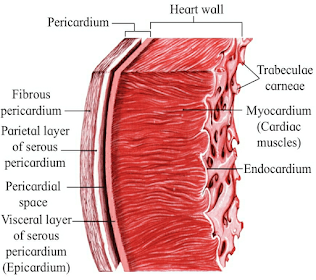The Human Heart
Introducation-
- The Heart is the main pumping organ of the circulatory system.
- It is reddish brown in colour, hollow and muscular organ.
- Its average weight is about 300gm in males and 250gm in female.
- It is conical in shape and lies in mediastenum i.e. the space between two lungs.
- It is broader at upper and conical at lower end (apex).
- Conical end is slightly tilted to left side and rests above the diaphragm.
- Heart is enclosed in a membranous sac called pericardium.
- Pericardium is formed form two main layers- outer fibrous pericardium and inner serous pericardium.
- Serous pericardium is soft, moist and elastic.
- It is formed of squamous epithelium and is further divisible into two layers as parietal and visceral layer.
- Parietal and visceral sublayers of serous pericardium are separated by a pericardial space.
- This space is filled with pericardial fluid which acts as a shock absorber and protects the heart from mechanical injuries.
- It also keeps the heart moist and acts as lubricant.
The Heart wall :-
- The heart is mesodermal in origin.
- Its wall is formed of three layers, Outer epicardium, middle myocardium and inner endocardium.
- Epicardium is thin and formed of a single layer of flat squamous epithelium resting on basement membrane.
- Myocardium is the middle thick layer formed of cardiac muscle.
- Endocardium is a single thin layer formed of squamous epithelium.
- The epicardium and endocardium are protective in function whereas myocardium is responsible for contraction and relaxation of heart.



Comments
Post a Comment